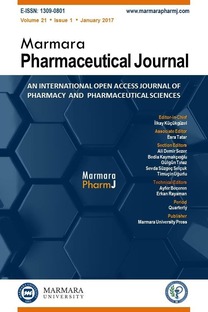Anticancer, antioxidant properties and phenolic, flavonoid composition of Heracleum platytaeniumplant methanolic extracts
___
[1]Bahadori MB, Dinparast L, Zengin G. The Genus Heracleum: A comprehensive-review on its phytochemistry, pharmacology, and ethnobotanical values as a useful herb. Compr Rev Food Sci Food Saf. 2016; 15(6): 1018-1039.[2]Pimenov MG, Leonov MV. The asianumbelliferaebiodiversity database (ASIUM) with particular reference to south-west asian taxa. Turk J Bot. 2004; 28: 139–145
[3]Taniguchi M, Yokota O, Shibano M, Wang N-H, Baba K. Four coumarins from Heracleum yunngningense. Chem Pharm Bull (Tokyo). 2005; 53(6): 701–704.
[4]Souri E, Farsam H, Sarkheil P, Ebadi F. Antioxidant activity of some furanocoumarins isolated from Heracleum persicum. Pharm Biol. 2004; 42(6): 396-399.
[5]Dincel D. M.Sc. Thesis. Isolation of secondary metabolites of Prangos ilanaeand Heracleum platytaeniumplants, investigation of their antioxidant and anticholinesterase activities. Department of Chemistry, Faculty of Science, Istanbul Technical University, İstanbul, Turkey, 2011. “(M.Sc. Thesis in Turkish with an abstract in English)”
[6]Kilic CS, Demirci B, Coskun M, Baser KHC. Chemical composition of heracleum platytaenium Boiss. (Apiaceae) essential oil from Turkey. Nat Vol Essent Oils. 2017; 3(4): 13-23.
[7]Aydin E, Turkez E and Taşdemir S. Anticancerand antioxidant properties of terpinolene in rat brain cells. Arh Hig Rada Toksikol. 2013; 64(3): 415-424.
[8]Stefano VD, Pitonzo R, Schillaci D. Antimicrobial andantiproliferative activity of Athamanta siculaL. (Apiaceae). Pharmacogn Mag. 2011; 7(25): 31-44
[9]Siegel RL, Miller KD, Jemal A. Cancer statistics,2017. CA Cancer J Clin. 2017; 67(1): 7–30.
[10]Cancer Research UK report 2013. http://cancerhelp.cancerresearchuk.org/ aboutcancer/ treatment/cancer-drugs/sideeffect, (accessed February 14, 2013).
[11]Banerji S, Cibulskis KC, Rangel-Escareno C, Brown KK, Carter SL, Frederick AM. Sequence analysis of mutations and translocations across breast cancer subtypes. Nature. 2012; 486(7403): 405–409.
[12]Ozmen V. Breast Cancer in Turkey: Clinical and histopathological characteristics (Analysis of 13.240 Patients). J Breast Health. 2014; 10(2): 98–105.
[13]Safarzadeh E, Shotorbani SS, Baradaran B. Herbal medicine as inducers of apoptosis in cancer treatment. Adv Pharm Bull. 2014; 4(1): 421–427.
[14]Raguz S, Yague E. Resistance to chemotherapy: New treatments and novel insights into an old problem. Br J Cancer. 2008; 99(3): 387–391.
[15]Liu RH. Potential synergy of chemicals in cancer prevention. J Nutr. 2004; 22: 3479-3485.
[16]Udenigwe CC, Ata A, Samarasekera R. Glutathione s-transferase inhibitingchemical constituents of Caesalpinia bonduc. Chem Pharm Bull (Tokyo). 2007; 55(3): 442-445.
[17]Prasad, KN, Cole WC, Kumar B, Prasad K C. Pros and cons of antioxidant use during radiation therapy. Cancer Treat Rev. 2002; 28(2): 79-91.
[18]Ata A, Bosch SAVD, Harwanik DJ, Pidwinski GE.Glutathione s-transferase and acetylcholinesterase inhibiting natural products frommedicinally important plants. Pure Appl Chem. 2007; 79(12): 2269-2276.
[19] Ghasemzadeh A, Ghasemzadeh N. Flavonoids and phenolic acids: Role and biochemical activity in plants and human. J Med Plants Res. 2011; 5(31): 6697-6703.
[20] Lin D, Xiao M, Zhao J, Li Z, Xing B, Li X, Kong M, Li, Zhang Q, Liu Y. An overview of plant phenolic compounds and their importance in human nutrition and management of type 2 diabetes.Molecules. 2016; 21(10): 1374.
[21]Ravishankar D, Rajora AK, Greco F, Osborn HMI. Flavonoids as prospective compounds for anti-cancer therapy.Int J Biochem Cell Biol. 2013; 45(12): 2821–2283.
[22]Mannervik B, Danielson UH. Glutathione transferases-structure and catalytic activity. CRC Crit Rev Biochem.1998; 23:283.
[23]Ramsay EE, Dilda PJ. Glutathione s-conjugates as prodrugs to target drug-resistant tumors. Front Pharmacol. 2014; 5: 181.
[24]Hu YJ, Diamond AM. Role of glutathione peroxidase 1 inbreast cancer: loss of heterozygosity and allelic differences in the response to selenium. Cancer Res. 2003; 63(12): 3347-3351.
[25]Ratnasinghe D, Tangrea JA, Andersen MR, Barrett MJ, Virtamo J, Taylor PR, Albanes D. Glutathione peroxidase codon 198 polymorphism variant increases lung cancer risk. Cancer Res. 2000; 60(22): 6381-6383.
[26]Glorieux C, Calderon PB. Catalase, a remarkable enzyme: Targeting the oldest antioxidant enzyme to find a new cancer treatment approach. Biol Chem. 2017; 398(10):1095-1108.
[27]Sakanaka S, Tachibana Y, Okada Y. Preparation and antioxidant properties of extracts of Japanese persimmon leaf tea (kakinoha-cha). Food Chem. 2005;89(4): 569–575.
[28]Erkan N, Ayranci G, Ayranci E. Antioxidant activities of rosemary (Rosmarinus OfficinalisL.) extract, blackseed (Nigella sativaL.) essential oil, carnosic acid, rosmarinic acid and sesamol.Food Chem. 2008; 110(1): 76–82.
[29]Lumachi F, Brunello A, Maruzzo M, Basso U, Basso S. Treatment of estrogen receptor-positive breast cancer. Curr Med Chem. 2013; 20(5): 596-604.
[30]Slinkard K, Singleton VL. Total phenol analyses: Automation and comparison with manual methods. Am J Enol Vitic. 1977; 28: 49-55.
[31]Simone CB, Simone NL, Simone V, Simone CB. Antioxidants and other nutrients do not interfere with chemotherapy or radiation therapy and can increase kill and increase survival. Altern Ther Health Med. 2007; 13(1): 22-28.
[32]Sharma OP, Bhat TK. DPPH antioxidant assay revisited. Food Chem. 2009; 113: 1202–1205.
[33]Habig WH, Pabst MJ, Jakoby WB. Glutathione-s-transferases the first enzymatic step in mercapturic acid formation. J Biol Chem.1974; 249: 7130–7139.
[34]Paglia DE, Valentine WN. Studies on the quantitative and qualitative characterization of erythrocyte glutathione peroxidase. J Lab Clin Med. 1967; 70 (1): 158-169.
[35]Aebi H. Catalase in vitro. Methods Enzymol. 1984; 105:121-126.
[36]Sriwiriyajan S, Ninpesh T, Sukpondma Y, Nasomyon T, Graidist P. Cytotoxicity screening of plants of genus Piper in breast cancer cell lines. Trop J Pharm Res.2014; 13: 921–928.
- ISSN: 1309-0801
- Yayın Aralığı: Yılda 6 Sayı
- Başlangıç: 1985
- Yayıncı: Marmara Üniversitesi
Analysis of anticancer drugs using thin layer chromatography–A review
Duygu UĞUR YENİCELİ, Alper UĞUR
Kevser TABAN, Nuraniye ERUYGUR, Osman ÜSTÜN
Licorice cream promotes full-thickness wound healing in Guinea pigs
Nafise HANAFI, Fereshteh TALEBPOURAMIRI, Somayeh SHAHANI, Reza ENAYATIFARD, Maryam GHASEMI, Abbas Ali KARIMPOUR
Shokooh KARIMI, Seyed Jalal HOSSEINIMEHR, Hamid Reza MOHAMMADI, Ali Reza KHALATBARY, Fereshteh TALEBPOUR AMIRI
Evaluation of antimicrobial activity of five Vincetoxicum taxa growing in Turkey
SEVDA GÜZEL, Gamze KÖKDİL, Mahmut ÜLGER, Gönül ASLAN
Assessment of in vitrogenotoxicity effect of homosalate in cosmetics
Songül ÇETİK YILDIZ, Cumali KESKİN, Varol ŞAHİNTÜRK, Adnan AYHANCI
Gökçen TELLİ, Banu Cahide TEL, Bülent GÜMÜŞEL, Kansu BÜYÜKAFSAR
Bambang KUSWANDI, Prawita SARI, Mochammad Amrun HIDAYAT
Simultaneous determination of selected flavonoids from different Cistusspecies by HPLC-PDA
PERİHAN GÜRBÜZ, Müberra KOŞAR, Zühal GÜVENALP, KURUÜZÜM Ayşe UZ, Lütfiye Ömür DEMİREZER
